How the Sakazuki is Changing
Nihonshu #03
Sakazuki—nihonshu serving cups—have been changing along with the sakes they hold in recent years. Ryota Aoki, a young potter, is breaking the conventions surrounding their production.
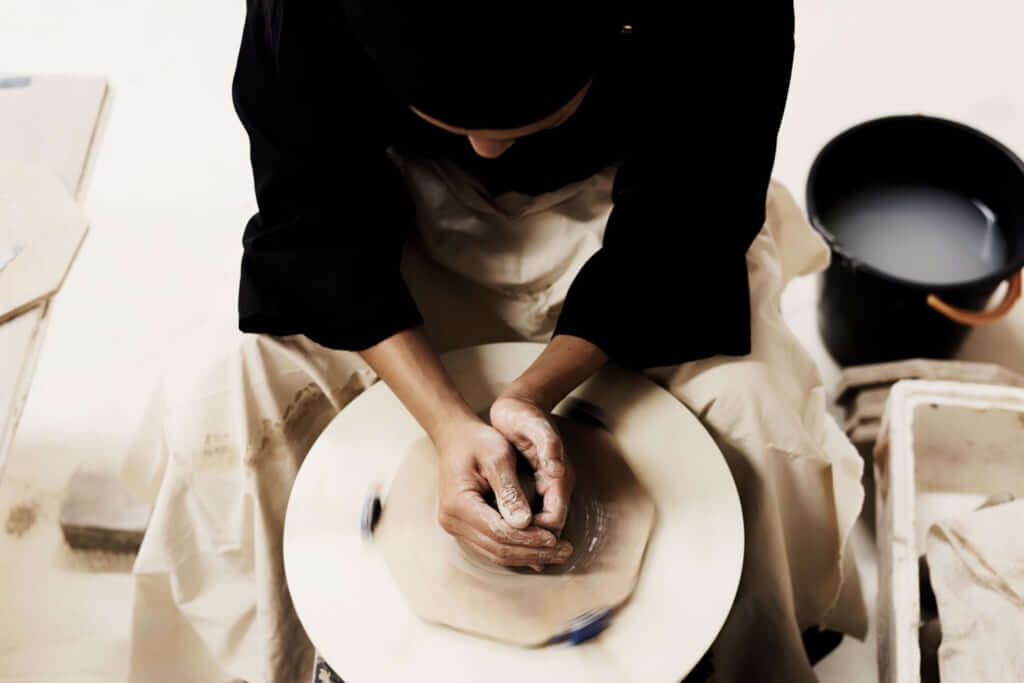
The hands of the artist, Ryota Aoki. He turns the wheel in his workshop, where rap music is playing at full blast.
‘Which cup would you like?’ In an izakaya or Japanese bar, one is rarely presented with a box containing various cups and invited to choose one. However, the ability to select a preferred size and shape, as well as the sensations acquired by touching the sakazuki are both involved in enjoying sake, just like carefully chosen nihonshu and its temperature. In addition to being used to drink the sake, sakazuki are, like the bowls used in the tea ceremony, vessels representing the personality of the individual, and they add a unique dimension to the time spent tasting. However, one simply cannot speak of sakazuki that enables the full nihonshu experience without also mentioning acclaimed potter Ryota Aoki. From traditional pieces used in tea ceremonies to more modern pieces representing artistic scenes, this potter’s work draws pottery lovers and collectors from the world over. In recent years, Ryota has come into the public gaze by making wine glasses and champagne flutes with shapes that are considered all but impossible to recreate in pottery. We met up with him in the town of Toki, in the Gifu Prefecture southwest of Tokyo, to learn about the tableware the artist is making as companion pieces to nihonshu, as well as the intricacies of his manufacturing process.
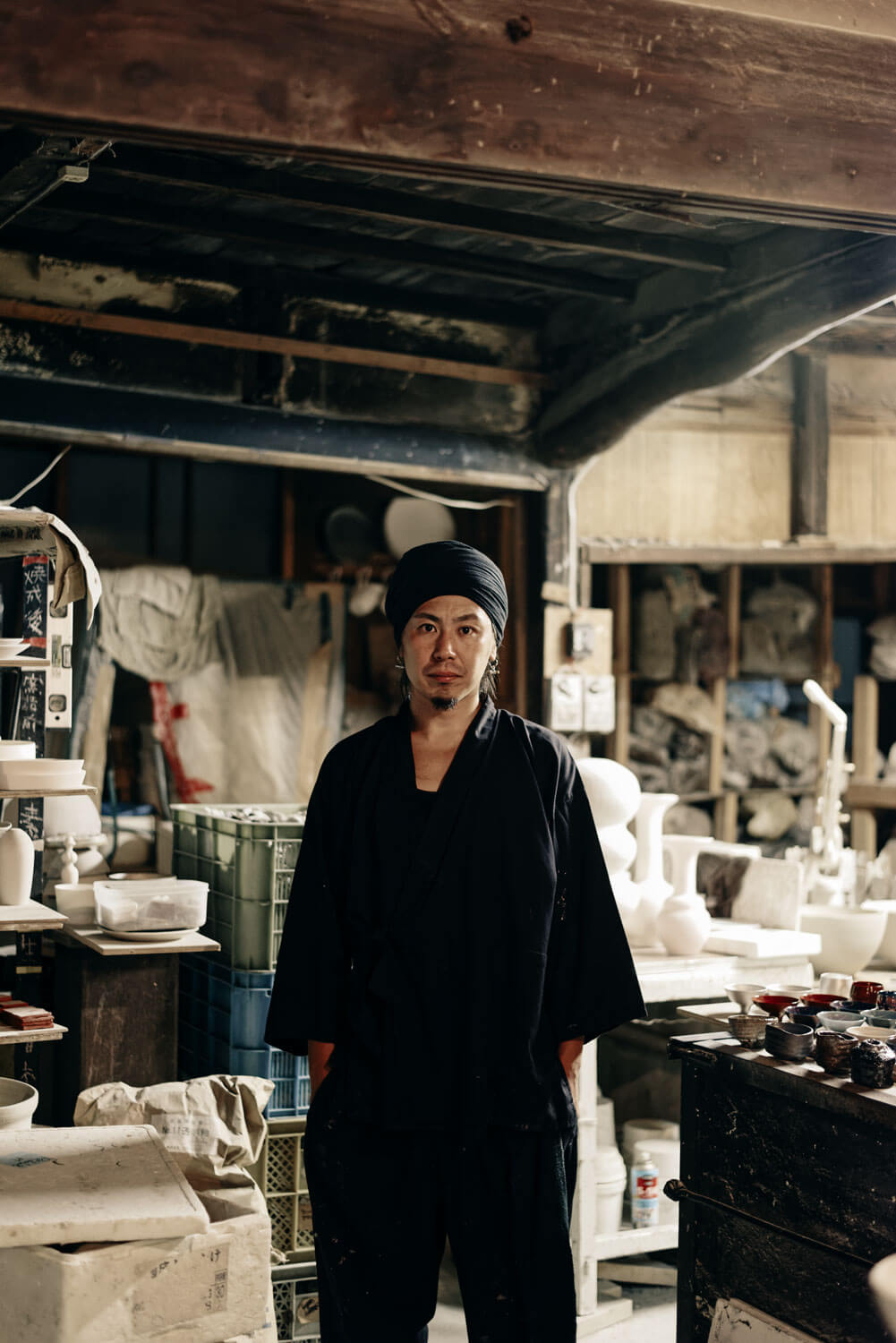
Born in 1978 in Toyama prefecture located in the northwest of the country, he set up his workshop in the city of Toki. The artist travels around the world to visit museums and potters, experimenting with various techniques and forms in his workshop.
Once inside the studio, the visitor’s gaze is drawn towards the numerous test pieces covering the walls: Elegant white porcelain tiles, tableware glazed with gold or platinum enamel, gleaming like multi-colored precious stones, and pieces reminiscent of bare mountain terrain, coated over with designs that bring to mind the powers of nature. As we admire these intricate works, we are left with no doubt that we have entered the birthplace of the many and varied wares of Aoki.
‘Fourteen years have passed since I made my first test piece. By now, I must have made more than a hundred thousand. Whether using earthenware, porcelain, or earthenware with a high iron content, the preparation and fabrication of every piece is never identical, even if a similar glaze is applied. The thickness and composition of the glaze depend on minutely accurate measurements, and this is why the preparation of test pieces cannot be delegated. Truth is, while it’s not something I’m overly-excited about, I still personally do much of the work in advance myself’, Aoki explains with a smile.
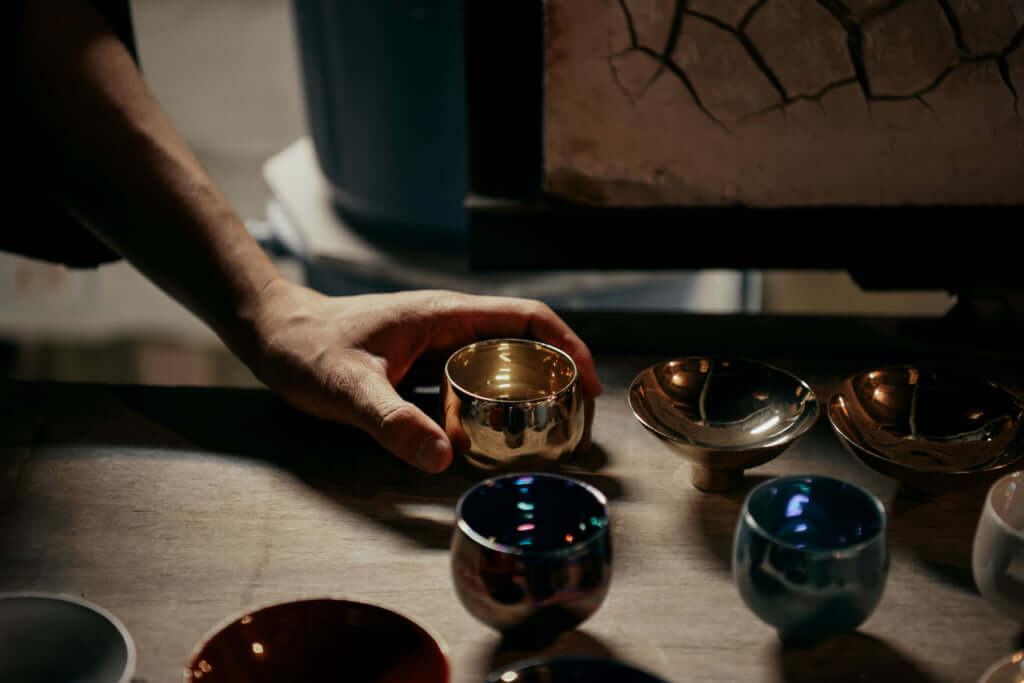
Shelves filled with pottery awaiting final firing.
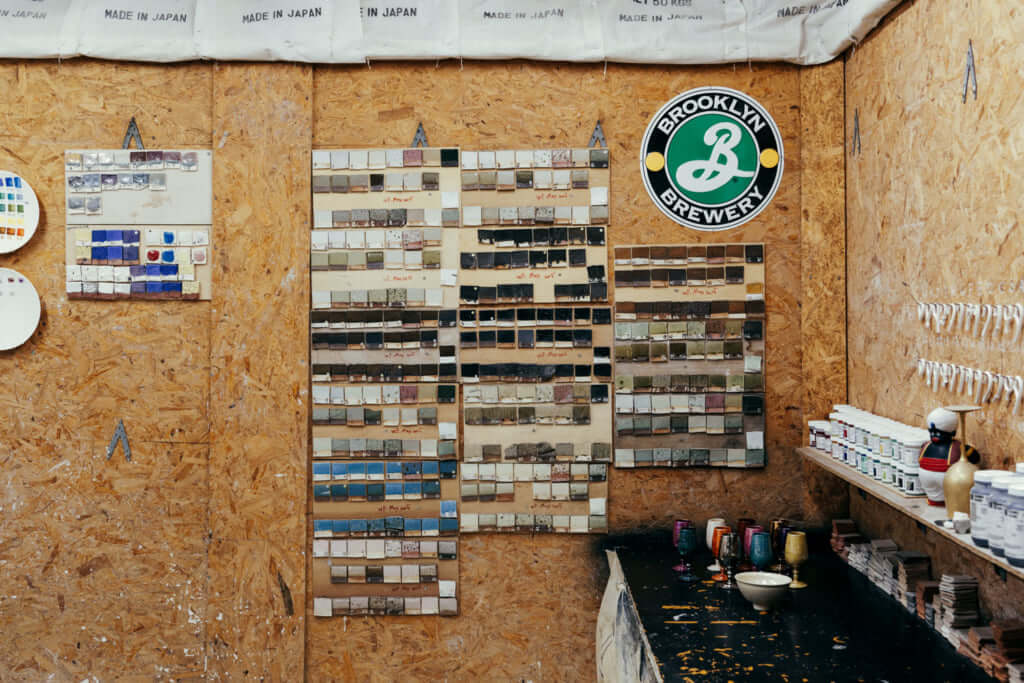
The walls are covered with test pieces on which the artist tries out different glazes.
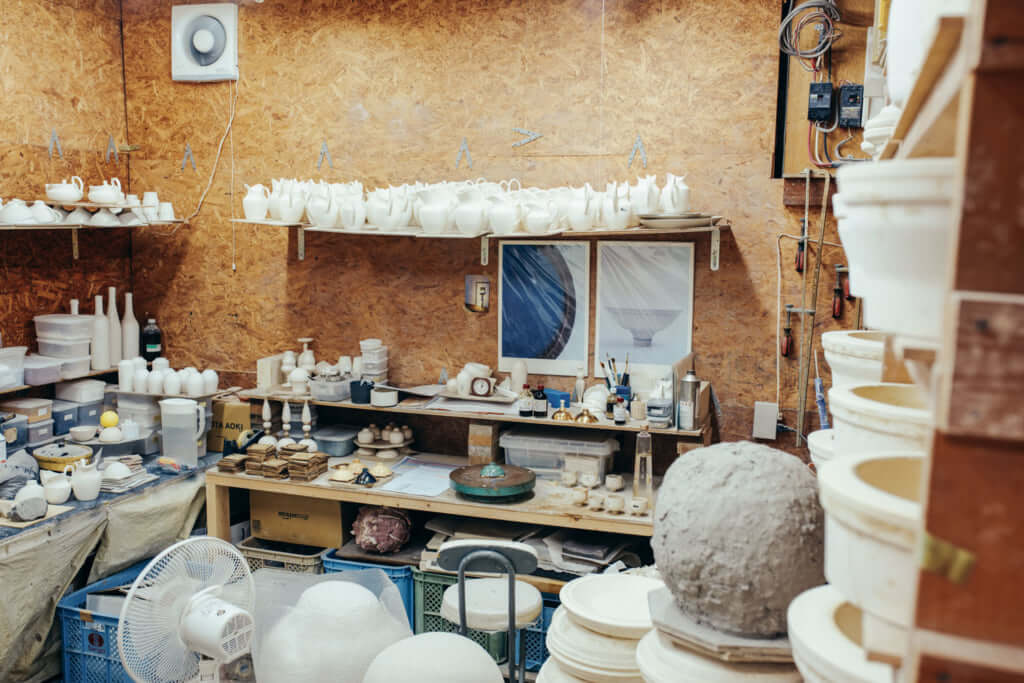
The walls are covered with test pieces on which the artist tries out different glazes.
Fashionista and Geek
The artist is, by his own admission, a ‘materials geek‘ Aoki likes to experiment with all sorts of materials, whether they be rough clay recovered from the mountains or processed clay purchased in a specialist shop. For the young potter, pottery is the ‘coming together of the earth and glazes to give birth to a new piece of work … I want to make pieces that have never been seen before. After graduating from university, I started designing pottery in a specialist school at Tajimi. At that time, I was fascinated by fairly austere ceramics, such as those of Shino and Kiseto. However, my classmates, most of whom had come from art schools, were producing pieces the like of which I had never seen before. It was then that I realized pottery as an art had no limits, and to imitate conventional pottery was a little like singing karaoke. Rather than repeating an old song, I came to understand that creating pottery should be like composing my own original score and melodies’.
While preparing to become an entrepreneur after university, the artist soon understood the need to develop original artistic techniques if he was to make pottery that were out of the ordinary. That was how Aoki started to manufacture test pieces. He also succeeded in forging cosmopolitan shapes, after having his senses honed by numerous visits to kilns and museums all over the world. Aoki emphasises that there used to be craft potters, starting with those from the Toki clan in the province of Mino, who wanted to express the design sense of forward-thinking tea masters of the Sen no Rikyu period, and these spearheaded the blossoming of the Japanese pottery culture. Often called ‘avant-garde’ by others because of the appearance and style of his creations, many view him as the heir to the techniques and spirit of these pioneering potters, who wanted to pass this culture on to future generations, something Aoki surely takes as a compliment.
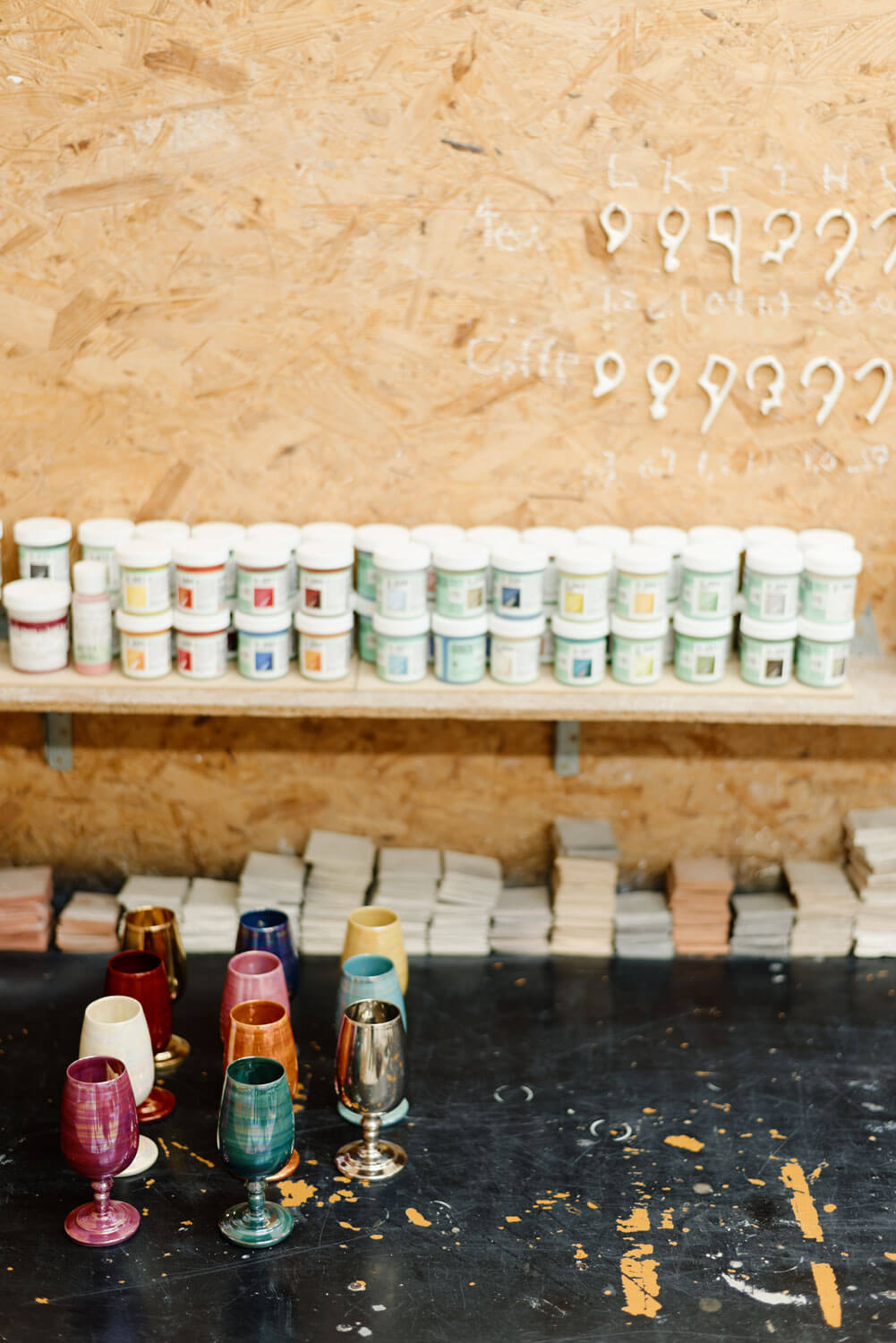
Shapes, colours, textures. The avant-garde pieces, produced in total freedom, have attracted the attention of numerous collectors.
Enhancing Aesthetics
From his range of pottery with glazed metal chips, to unique pieces where the edges have been adorned with an iron-rich glaze, or even earthenware in which a rougher appearance has been kept, all of the artist’s works are imbued with different personalities.
‘The thickness of earthenware sakazuki edges is not uniform if I throw them on the wheel – some points are thicker than others and it’s very interesting to search for the best spot to place one’s lips to drink. Good handling of the object is equally important. The sensation of touching an iron-rich glaze is completely different from that of a platinum glaze. There will always be a shape that is more pleasant to handle than others for someone, and a glaze with a texture matching the expectations of every individual. This is why I would like people to choose the works that please them’, comments the artist, who is also a lover of nihonshu. Unlike standardised industrial products, every day, Aoki marries innumerable materials with glazes and skillfully tries out new materials to stimulate our five senses.
Nihonshu —
#01: Nihonshu: Crafting Sake >
#02: The Last Barrels of Tradition >
#03: How the Sakazuki is Changing
#04: Nihonshu and Tsumami: An Audacious Pair >
TRENDING
-
Colour Photos of Yakuza Tattoos from the Meiji Period
19th-century photographs have captured the usually hidden tattoos that covered the bodies of the members of Japanese organised crime gangs.

-
The Tattoos that Marked the Criminals of the Edo Period
Traditional tattoos were strong signifiers; murderers had head tattoos, while theft might result in an arm tattoo.

-
The Nobu Empire, the Fruit of the Friendship between the Chef and Robert De Niro
The two men are partners in Nobu Hospitality, a luxury restaurant and hotel brand that has become a global success.

-
Hayao Miyazaki, the Man Who Adored Women
The renowned director places strong female characters at the heart of his work, characters who defy the clichés rife in animated films.

-
The Tradition of the Black Eggs of Mount Hakone
In the volcanic valley of Owakudani, curious looking black eggs with beneficial properties are cooked in the sulphurous waters.





